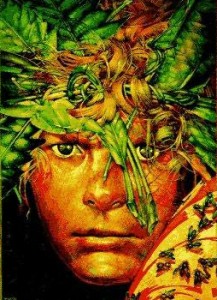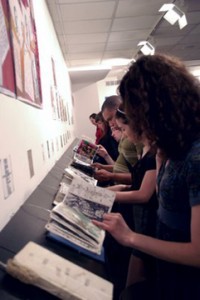
Barron Storey, " Lord of the Flies" book cover (detail from 1980 edition)
Making art is part of a ground level experience. The artmaking process can be sensory, visceral and seemingly fleeting, depending on the methods of record of an artist’s choosing, be it film, painting, photography, or sculpture. It’s a hands-on way to attempt to materialize the momentary into something lasting.
In response to guest blogger Thomas Micchelli’s acknowledgement of drawing as the direct route to the subconscious, I believe that the drawing process is one of the most fascinating methods that artists, as purveyors of information, employ as a platform for critical reflection.
Up now at the Society of Illustrators until June 25th, is Life After Black, an exhibition of one hundred and sixty journals made by Barron Storey, celebrated artist and teacher.
These black books envelope years of Storrey’s thoughts illustrated through the many adventures of his day-to-day life, often via the inspiration of many literary works from authors such as the Marquis de Sade or William Shakespeare, among many others (including William Golding’s novel Lord of the Flies).

Barron Storey, "Life After Black." Installation view at the Society of Ilustrators, 2009
Flipping through the plethora of pages, the viewer is presented with the visual view of Storey’s interior data bank: from personal daily notes, charts, lists, and various quotes. He doesn’t hold back.
These journals are drippingly raw, full of force in their sincerity, and intellectually gripping in their multi-layered approach to a specific narrative subject matter. His technical ability with drawing tools can be inspiring for any artist with a special love for such materials.
Joe Fusaro has encouraged, in an installment of his Teaching with Contemporary Art column, that sketchbooks are a useful way to store information, develop ideas, and actively think. Barron does this in a way that is special and unique. As one of Barron’s avid former students (and fellow classmate of mine), Jeremy Forson, recently mentioned in conversation: “For Barron, drawing really is about an adventure. Barron was always encouraging his students to go outside, on an adventure, and draw what you see. And he practices what he preaches devoutly.”
With that, I would like to end on a quote Barron Storrey excerpted from a 2007 original audio interview:
I’m not aware what’s real until I go to my journal. At this point, it has been such a part of thought process and my seeing and my experiencing of life. It is completely integrated. I carry the thing with me all the time; sometimes I go someplace and I go hours and hours and I haven’t even touched my journal. It’s with me.



